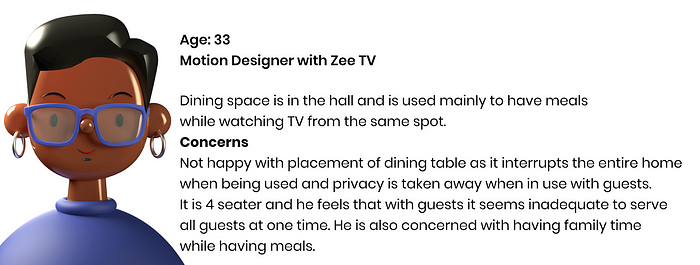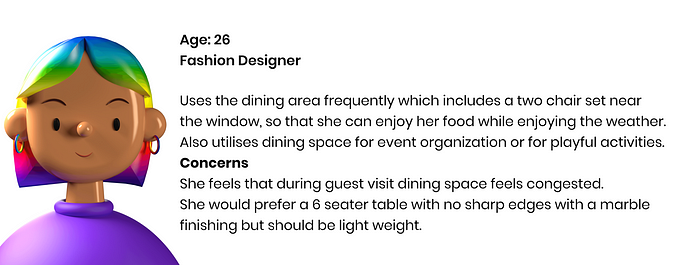An Infinite seater Dining Table: A Design Thinking case study
Offering food to your guests and feeling guilty for not being able to serve them all at once, I have a solution!

What is design thinking and How to apply it are the few questions we will answer through this case study.
Introduction
The story of how I reached on designing a dining experience that is flexible based on your requirement comes from getting hands-on experience of working on a UX Research Project conducted by Anudeep Ayyagari (UX Designer, Amazon).
We in a team of 10 were allotted different areas of a house aiming to solve the problems that users commonly faced while using that specific area of home aiming to enhance their experience.
I was allotted “Dining Space”. So, I am about to take you on a journey of improving your dining experience.
The significance of the project is to apply the Design Thinking process which would develop a unique approach for problem-solving.
Design Thinking
A 5 step process
Empathize — Define — Ideate — Prototype — Test
Let’s understand how to apply the Design Thinking process step by step in easy words using our area of research “Dining Space”.
1. Empathize
Design thinking brings a complete revolutionary change in the way a self-taught graphic designer approaches a problem. Because now you have to put your tools/software away and talk to your users before brainstorming for the solution! Seems natural, isn’t it? But it is hard!
Because we designers already have the tendency to make design decisions on behalf of our users and thinking in our own mind as a user. So, here comes the first big take away:
“You are not your user. Go talk to them to understand their experiences.”
After having this paradigm shift I interviewed 5 members of my team to understand their dining experience.
But wait! What am I supposed to ask them specifically?

For this, I prepared a set of questions in advance and as per the guidance of our mentor, I made sure that I do not mention my own answers to their problems while I am in conversation with them. Hey! you remember this too!
1. Do you have a separate dining space at your home?
2. How do you feel about your dining space while using it with your family?
3. How do you feel about your dining space while using it with guests?
4. How often do you use your dining space?
5. Would you like to eliminate the Dining Table and add it to the kitchen?
6. What kind of inconvenience do you feel while serving your guests?
7. What kind of table shape do you have or want to have?
8. How many seater dining table do you have?
9. Which material is your dining table made of?
10. What are the other things you require in the dining room?
11. How is your dining space connected with the kitchen like through a window?
These are just a few questions but when a user answers a question you automatically come up with a few on the spot.
12. Does your dining table have any kind of facility to feed your pet simultaneously while having your meal?
13. Is your dining table multipurpose or just used for eating meals?
With just one step of interviewing I started to understand how the design thinking approach made a difference because I was able to gather insights that I wouldn’t have thought of on my own while assuming myself as a user.
Thus, we are done with Stage 1 of the Design Thinking Process which is called Empathise.
Just see how natural this process of problem-solving is and then the Big term called “Design Thinking” that has received so much attention will feel very easy to apply.





2. Define
After analysing all the experiences here are the specific problems that were faced by them and why they are important
- The size of the Dining table in all cases felt inadequate when guests arrive.
Do your guests ask you how many people your dining table can accommodate? So that they could plan their visit accordingly 😂
Thus, this is one major issue faced by every one of them.
So, this is one area that needs improvement. - Carrying used utensils after a meal is a difficult and boring task. Everyone is super excited before having the meal but once done it becomes tedious work to carry the used utensils one by one to the kitchen.
- Dining Space is not usable for work or other events when idle.
Most people have their dining space in their lobby or hall thus once the meals are done dining area is usually idle and can be used to work or be of certain use while organizing some activities/games at home.
Other problems that were mentioned by users:
- Dining Space somehow doesn’t support those who are taller (While hearing this problem I also felt this stood true for people with special needs or old aged people).
- The weight of the table is an issue to move it easily around the hall.
- Storage issue in or near dining table to be used for snacks or crockery.
- No facility for pets to be fed simultaneously at the dining table.
- Sharp edges/corners of the dining table.
- Placement of Dining table in the home so that it doesn’t interrupt the entire home and its privacy.
- To attract members to eat together at the dining table so that the entire family can have time together.
From here specifically taking notice of the first three problems we have defined the following problem statement:
A multipurpose expandable dining table that can flexibly accommodate more people if need be when guests arrive.
3. Ideate
Here comes our infinite seater dining table which never makes you feel guilty about not being able to accommodate all your guests at once! Just kidding.
Now is the stage when we start thinking of all possible solutions to the problems our users faced.
- Double plank table that can be slid out which will double the size of the table.
- A storage cabinet shaped table whose two opposite doors can be pulled out and form a stable surface for the table. Placed along a wall which will be opened up as dining table only when need be.
- A part of the table can be extracted as a trolley.
- A table divided into segments whose sections can be individually opened like a book which will increase the size of the table and the same segment can be lifted at an angle which can be used to read a newspaper, work on a laptop or paint.
- In the bottom, there can be a clamp like holder for a small pet feed utensil where the pet can be fed simultaneously while you are having your meal.
- Atleast one chair with dining table set should be adjustable as per the individual. It should be able to accommodate people with special needs like serving your grandparents.
- The table has to be designed in a way that normal chairs should be usable with an increased table area.
The top 3 ideas are 🥇🥈🥉
- A table divided into segments whose sections can be individually opened like a book which will increase the size of the table and the same segment can be lifted at an angle which can be used to read a newspaper, work on a laptop or paint. (See prototype section to understand how it works)
- Atleast one chair with dining table set should be adjustable as per the individual. It should be able to accommodate people with special needs like serving your grandparents.
- A double plank surface of the table where the second plank can be slid out when need be.
In all cases, if someone has a pet a small clamp can be designed which could be attached to the table’s leg for placing the utensil.
4. Prototype
Prototype Iteration 1:
This is a basic iteration where I developed an approach to a solution without analysing the feasibility because when we try to think in restrictions it becomes difficult to ideate.
While ideating do not think of restrictions, let your imagination run wild.
But, in order to showcase you my complete thought process, I decided to describe it briefly in the case study. Because this is how ideas evolve into solutions that are worthy.
- The planks that are opened like a book from the table surface to extend the table are the same planks that can be held at an angle with a support behind them which can be useful for reading the newspaper or while working on a laptop. (For understanding how, refer to the illustration of prototype 2)
- The entire table is divided into various detachable sections that can be used as a study table.
- All the sections have wheels that can act as a trolley to carry utensils and also easily move the entire dining table around the house.
User Review for Iteration 1
- The structure is complex to be understood easily by all age groups.
- To design a dining table with so many flexible planks which can be adjusted as per need will be expensive.
- The stability of the table will be less because of the detachable sections with wheels.
Prototype Iteration 2
Keeping this feedback in mind, I tried to reduce the complexity in the following ways:
- A 4 seater table is the one which is minimally required for nuclear families, and expandable upto 8 would help them.
- The last iteration had many folding planks but I reduced them in this one.
- The entire table will not be divided into detachable parts but only 1/4th part of it will have the wheels which will be used as trolley.
- The trolley wheels will be put up underneath a plank of wood to give a stable moving functionality.
- The legs of the table are specifically put in centre of each division, to make the structure more stable while being used in expanded form.
Three significant features of the Dining Table:
1. Expandable from 4 to 8 seater.
2. When idle, the table can be used as a work/study table.
3. A part of the table can be extracted to be used as a trolley.

User Reviews and Rating for Iteration 2
User 1:
⭐⭐⭐⭐
Completely satisfied with the upgradation to the second prototype.
User 2:
⭐⭐⭐⭐⭐
Appreciated the design while mentioning the functionality of the trolley being kept in one section, a good design decision as it will keep the rest of the table stable.
User 3:
⭐⭐⭐⭐⭐
Happy with the solution, would like to understand further and know about the carpenter’s view on the trolley section.
User 4:
⭐⭐⭐⭐
Appreciated the idea. Adding on to this he discussed about the interest to know the estimate of costing to analyse the user base which would be able to get such dinner table installed.
Thus, this was the infinite dining table design which wasn’t really infinite but it might be of help to many households who have felt the same problem.
Blog, Design Thinking, Project, UX Design

” Design is a tool of communication, use it wisely.”

Stay Tuned
Have a query?
Have a query or project?
Say hi or mail your concern at
design@harnoorbhullar.com

This Post Has One Comment
May I simply say what a relief to uncover somebody that really understands what theyre discussing over the internet. You certainly know how to bring a problem to light and make it important. More and more people really need to check this out and understand this side of the story. I was surprised that youre not more popular because you certainly have the gift.